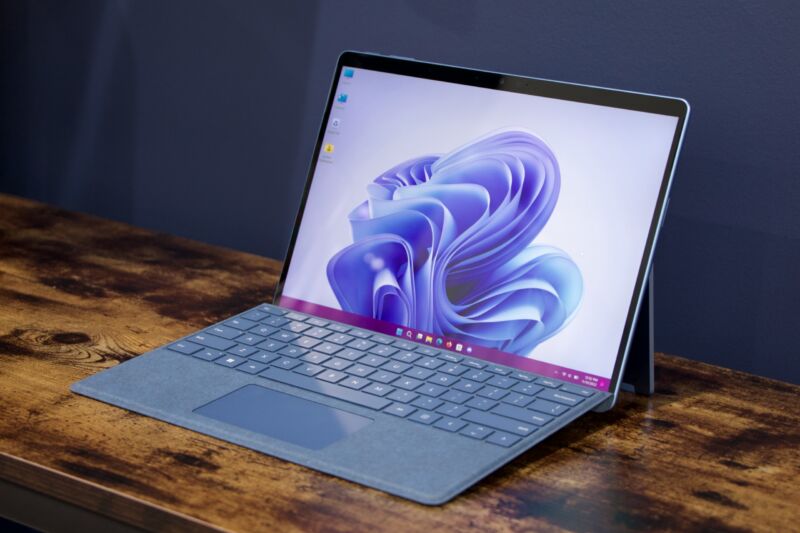
Tablets looked to take the computing world by storm during the iPad’s meteoric rise, but they have now stabilized into their role as a secondary device oriented around convenient content consumption and portability—at least as far as at-home use goes. Still, tablets are hugely popular, especially with families where kids and adults each want their own computing solution, but not everyone has room for a desk.
And given that younger generations are touch-first, keyboard-and-mouse second, and there are plenty of reasons to spring for one or more tablets these days. While Google has struggled to translate its Android smartphone operating system into a viable tablet platform, Apple’s iPad dominates the market, with Amazon’s Fire lineup covering a lot of other users.
There’s also the sort-of-tablet Surface line of products from Microsoft, which are aimed more at productivity and power users. Today we’ll go through our best tablet picks for different types of users and use cases based on our time reviewing these devices. Let’s dig in!
Ars Technica may earn compensation for sales from links on this post through affiliate programs.
The ideal tablet for most people: iPad Air 5th generation (2022)
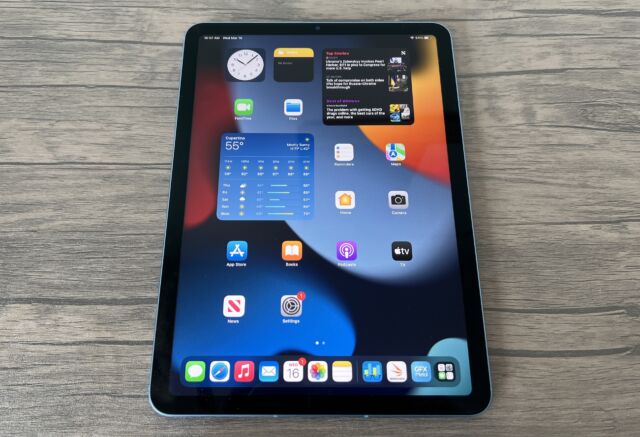
Apple iPad Air 5th Generation
Ars editor Samuel Axon has said it again and again in our reviews: the iPad Air is “the best deal in Apple’s tablet lineup in terms of performance and features you get for the price.”
Sure, if you just need a good, reliable tablet for the basics and want to spend as little as possible, the 9th-generation iPad is there. (And it’s our budget pick found below.) But for a step up to the latest design, colors, faster USB-C charging, and more performance than a tablet of this kind needs, then we recommend the latest iPad Air.
The Air is nearly the same dimensions as the 9th-generation iPad, but it fits a slightly larger 10.9-inch screen (as opposed to the 9th-gen’s 10.2) into its frame, thanks to a more modern design with slimmer bezels. It replaces the older iPad design’s home button with gestures that only take a short time to learn. You also get a markedly upgraded display that covers much of the DCI-P3 color gamut. But unlike the even-more-expensive iPad Pro, the Air still doesn’t get FaceID—instead, the Touch ID sensor is relocated to the power button atop the iPad. We’ve never had any big complaints about Touch ID in its current implementation, though.
The real star of the iPad Air is the M1 chip, which puts this consumer tablet in the same performance class as the lowest-end MacBook Air as well as the 24-inch iMac. Apple also equipped the Air with 8GB of RAM, making this iPad quite the powerhouse for those who’d like to work, game, or multitask heavily. In the unlikely event that you’re going to do a lot of creative productivity work, it will actually serve you quite well.
Add Apple’s Magic Keyboard or a less expensive, backlit keyboard like Logitech’s Combo Touch to complete the productivity package.
The good
- A display that’s about as good as LCD displays get in this size
- Modern design with slimmed-down bezels
- Supports the latest and greatest Apple Pencil
- M1 processor will serve just about anyone’s tablet needs
The bad
- Optional Magic Keyboard is an ultra-expensive add-on
Budget alternative: iPad 9th generation (2021)
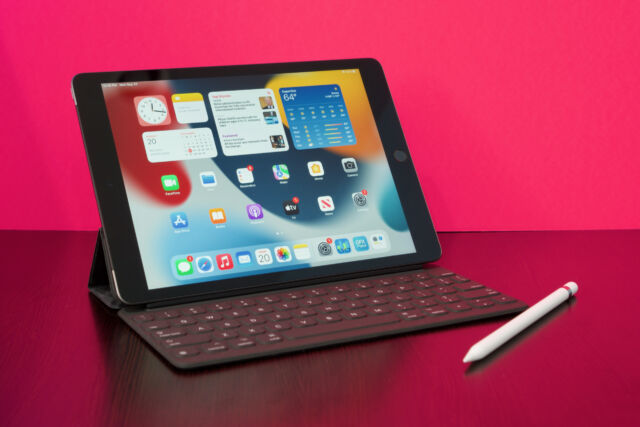
Apple iPad 9th Generation
Many people will get by just fine with Apple’s entry-level iPad. Like its pricier cousins, it has an unmatched app ecosystem. Add in Apple’s lengthy software support —usually around four or five years, and even longer for critical security updates—and you’ve got a secure Internet device that bests most of what is offered in the Android camp.
For those who want a tablet for consuming media, web browsing, and occasional productivity, the 9th-generation iPad (2021) is a reliable choice with solid hardware to meet the task. Remnants from Apple’s aging design archives, like the home button and Touch ID, may make the standard iPad look stale compared to other devices in the company’s lineup, but as we noted in our review, Apple “doesn’t skimp on construction and materials, so your hardware still looks and feels nice despite being a bit dated.”
Running on the same A13 chip design as the iPhone 11 and 11 Pro with 3GB RAM and 64GB storage, the 9th-generation iPad will be a smooth operator for most tablet tasks, like watching movies or browsing the web. You’ll need to up the performance to play the latest 3D games, though, and the screen is just fine by today’s standards, whereas the higher-end iPads really up the ante there for HDR movies and the like.
The 12-megapixel front-facing camera supports Center Stage, leveraging artificial intelligence to keep you in the middle of the frame on FaceTime calls. That said, this feature can be a bit wonky at times, so it may not be to everyone’s taste. If you think you’ll do some note-taking, emailing, or document editing, you can add Apple’s $160 Smart Keyboard. Our reviewer preferred Logitech’s $150 Combo Touch keyboard for its superior typing feel, trackpad, and loop to store your Apple Pencil.
A couple of things to note: This iPad uses a Lightning cable to charge (versus newer iPads that use USB-C) and only supports the first-generation Apple Pencil. Rumor has it Lightning may soon be sunsetted in Apple’s lineup, so in that sense, it’s not the most future-proof. Many people will be just as happy with the first-generation Pencil as the newer one, but it’s worth noting that it has a bizarre charging solution that’s a bit unwieldy, and it just doesn’t feel as nice to use on the iPad’s cheaper screen.
The good
- Relatively affordable price
- Access to robust catalog of iPadOS apps
- Support for keyboard, mouse, and Pencil
- Long period of time for software support
The bad
- Charges via Lightning instead of USB-C
- Apple Smart Cover keyboard case is expensive
- The screen is just OK
- Lacks the Mac-like performance of more expensive iPads
Another option for kids: Amazon Fire 7 Kids, Amazon Fire HD 8 Kids
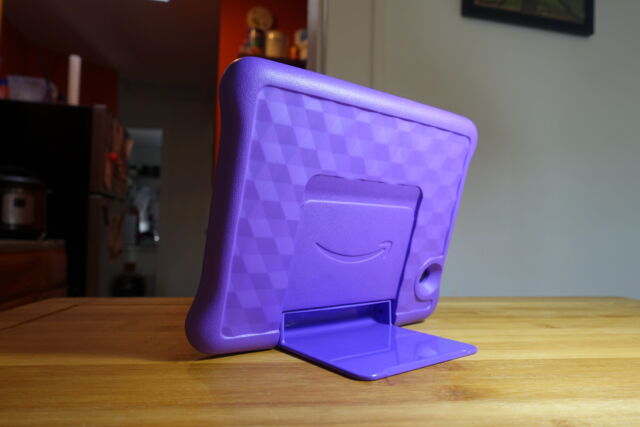
Amazon Fire Tablets for Kids
If you have kids between the ages of 3 and 12 and want to spend around $100 on a tablet, Amazon’s Fire tablets have some great options.
The Fire 7 Kids tablet is designed with children in mind. It’s a 7-inch slate with a colorful 1.1-inch thick case and built-in adjustable kickstand, doesn’t have ads, and comes with a two-year “Worry-Free Guarantee.” Amazon says, “If it breaks, return it and we’ll replace it for free.”
It also comes with a one-year Amazon Kids+ subscription with access to a range of kid-centric apps and shows, including original content and some from Disney, Nickelodeon, Lego, PBS, and more. There’s also a set of configurable parental controls. And with 16GB of RAM, USB-C charging, and a microSD card slot, this kid’s tablet checks off a lot of boxes.
For older kids, a slightly larger Fire HD 8 Kids tablet provides more screen canvas for content and up to 13 hours of battery life. The thicker case and slightly heavier weight make the larger variant less ideal for younger children, but you’ll still get access to the same year-long Kids+ subscription, two-year warranty, and access to fun and educational content.
If your child is a little past the age of having a thick, colorful, nearly indestructible case and could benefit from a larger tablet, the regular Fire HD 10 is a great step up. The Fire HD 10 is a more grown-up tablet, lacking the chunky child-proof case of its smaller siblings, though it still comes in fun colors. For that trade-off, you get the larger screen, options for 32GB and 64GB models, and the option for use with a keyboard case that only adds about $30 to the price.
The Fire 7 Kids version is regularly on sale for between $60 and $70, but the full retail cost is $110. It’s still a decent value at full price, but with frequent sales, we’d recommend buying when a discount pops up.
The good
- Excellent warranty
- Frame is bulky but adds to durability
- Pre-loaded educational content
The bad
- Amazon Kids+ subscription limited to one free year
The hybrid alternative: Surface Pro 9
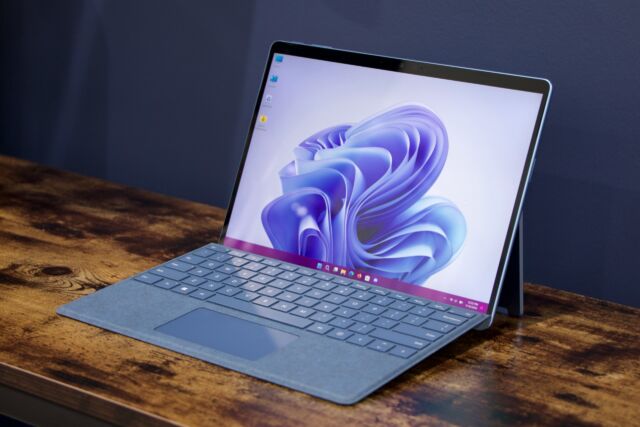
Microsoft Surface Pro 9
If you want a computer first and a tablet second, Microsoft’s Surface Pro 9 should be at the top of your list. It has a nice 13-inch screen with an option for a 120 Hz refresh rate, a range of processors and storage configurations to choose from, and access to a robust ecosystem of apps and programs designed for desktop Windows. These features make this tablet one of the best laptop replacements on the market today.
Its iconic form factor integrates a built-in, adjustable kickstand and pairs with a magnetic, optional backlit keyboard cover that could be angled upward for better ergonomics. When the optional keyboard cover is attached and used with the kickstand, it may be an issue for those who like to use their notebooks on their laps.
You can also add the Surface Pen to take notes, sketch, and act as a mouse with right-click functions. For other peripherals, like external displays or portable solid-state drives, the Surface Pro 9 has two Thunderbolt-compatible USB-C ports.
The Surface Pro 9 runs Windows 11, which means it can run any Windows-compatible program, as well as Android apps available on Amazon’s Android app store with the Windows Subsystem for Android support.
The entry-level model (Intel i5 processor, 8 GB RAM, 128GB) is often the same price on sale as the 256GB model, so you can get a little more for your money. From there, you can option the Pro 9 all the way up to an i7 processor with 32GB RAM and 1TB storage, with eight configurations in between. Microsoft also offers a 5G version that comes with a Qualcomm-made Microsoft SQ3 Arm processor.
The good
- Slim tablet that runs Windows 11 with access to complete Windows ecosystem of apps and programs
- Robust multitasking capabilities
- Elegant and premium design
- Choice of Intel or Arm-based processors
The bad
- Keyboard cover is not included in the box
- Lap-comfort issues with kickstand and keyboard cover
- Arm version suffers from some sluggish performance
Best for Android users: Samsung Galaxy Tab S8 Ultra
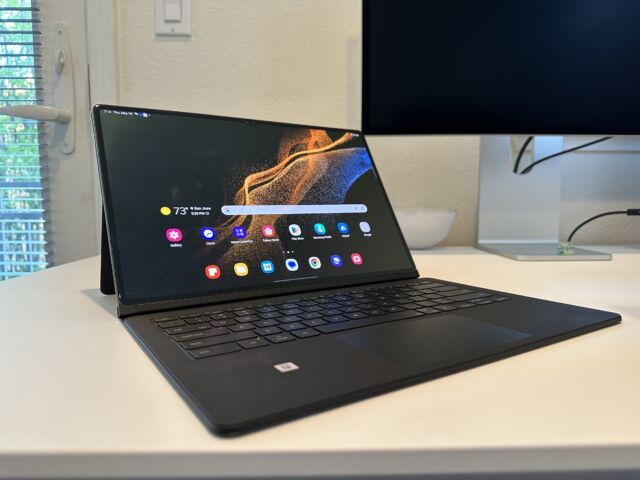
Samsung Galaxy Tab S8 series
Samsung’s premium Galaxy Tab S8 Ultra is a tablet that does it all, with a spacious 14.6-inch display. And though portability is hindered with such a large screen—don’t be fooled, however, as the Tab S8 Ultra still manages to pack in plenty of features into a slim 5.5 mm form factor—productivity is elevated with a vivid AMOLED display for content consumption, a bundled digital S-Pen stylus for creativity tasks, and Samsung’s One U.I. multitasking software to juggle multiple apps at the same time.
Like the iPad, Samsung’s support for the Android operating system makes the Galaxy Tab S8 Ultra a touch-first computing device. And similar to its Apple competitor, you can add Samsung’s Book Cover Keyboard case for productivity. The case includes a trackpad, a kickstand cover for the tablet, and a backlit keyboard, which comes in handy to write notes, compose emails, and enter passwords as a laptop alternative. Where the Galaxy Tab excels is multitasking, and Samsung’s approach to juggling multiple windows simultaneously with its DeX interface combines the best of the iPad and Surface Pro in one slim device.
Like the iPad, you get access to a robust library of mobile, tablet-first apps, but like the Surface Pro, you run multiple resizeable windows simultaneously. In standard Android mode, the tablet can snap together multiple windows on its screen, running them smoothly side by side. This makes the Galaxy Tab S8 one of the closest desktop replacements for a consumer slate that doesn’t run Windows.
For productivity and content consumption, Samsung’s large screen has its advantages, but there are some disadvantages if you prefer to use your device handheld as a tablet. With a wider aspect ratio in landscape mode that allows the tablet to feel like a laptop, the Galaxy Tab S8 Ultra is horrible ergonomically in portrait orientation with a longer, top-heavy screen. This is really a shame, as the bundled pressure-sensitive S-Pen is a joy for drawing, doodling, and note-taking. And even though some users complained about the notch in the display to accommodate the front-facing camera due to the Tab S8 Ultra’s slim bezels, we got used to the peculiar design and weren’t too bothered by it in daily use for video calls; just don’t try to use this unwieldy tablet as a replacement for a camera or smartphone. If you need to use the slate in portrait orientation as a tablet, we’d recommend the standard Galaxy Tab S8 or Galaxy Tab S8+ instead.
The large footprint of the Galaxy Tab S8 Ultra allowed Samsung to squeeze in an impressive 11,200mAh battery, which can give the Tab S8 Ultra a range from 8 to 13 hours.
Most users who adopt the Galaxy Tab S8 Ultra will find the tablet’s prosumer features appealing. The tablet can serve as a Wacom replacement for digital artists who want to doodle or draw on the large screen. And while Samsung’s One U.I. software can be polarizing—the company’s first-party apps confusingly overlap with native Google offerings—we appreciated that the software was able to truly take advantage of the slate’s hardware and deliver an unrivaled multitasking experience on a mobile device.
If the Galaxy Tab S8 Ultra is too pricey for your budget, Amazon has recently entered the productivity slate space with its Fire Max 11. Amazon’s tablet ships with an 11-inch screen. Like the Galaxy Tab S8 Ultra, can be configured with an optional keyboard case with kickstand and pen; the Fire Max 11‘s productivity bundle comes in at a little more than half the cost of Samsung’s 11-inch Galaxy Tab S8 without the keyboard cover for comparison. And while both slates run Android, Amazon uses a forked version of Google’s OS. The retailer also replaced Google’s Play Store with its app store. Unlike Samsung, there’s no DeX equivalent on the Fire Max 11 for those who prefer a desktop-like UI with resizable windows.
The good
- Samsung DeX multitasking mode combines the best of Android and Windows multitasking in a consumer tablet
- Large, vibrant display for entertainment and work
- Access to a large catalog of touch-first Android apps
- Pen is included and can magnetically charge on the tablet
The bad
- Doesn’t run pure Android; comes with Samsung’s One U.I. overlay.
- Keyboard folio case is optional and adds to the cost of the tablet
- Tablet use is awkward with screen aspect ratio that’s too long in portrait mode
https://arstechnica.com/?p=1946193

